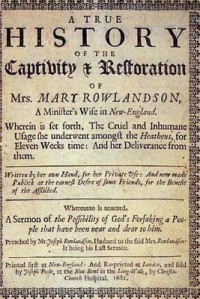A True History of the Captivity and Restoration of Mrs. Mary Rowlandson.: By Mrs. Mary Rowlandson; And Introduction by Atidem Aroha (Full Original Text).

On February 10th 1675* "came the Indians with great number upon Lancaster."
Lancaster, MA, at 30 miles West of Boston, was a frontier town and vulnerable during King Phillip's War. There had been some anticipation of attack as the army had left the area. Mary Rowlandson, her three children, her sisters and their families and other neighbors were burned out of their garrison into a shower of bullets. 24 were taken prisoner and nearly as many killed, all were close family members or neighbors. Mary witnessed all of this.
Mary's account of her captivity is brief, poignant and rich in detail. She describes her captivity in "removes", as she physically moves farther away from her home, but also spiritually from her previous life. Her children have been taken from her, and all familiar faces, she is told her husband thinks her dead. Mary sees herself undergoing a test from God, and fierce and unapologetic she goes about doing surviving. She learns to forage for food, sews clothing for the Indians and is paid for it, she begs food - something for which she is beaten - and takes it. She is grateful and acknowledges small kindnesses from Native Americans, but she is constantly on defense. She is on the whole contemptuous and fearful of her captors, relying on scripture to escape from the reality she's living.
There is little exterior information in Mary's narrative, but there is much that can be learned about the Indians of that period. A century of plagues reduced their populations, destroyed whole villages and family groups. They experienced greater losses than Europe during the black death and had colonial invasion on top of it. The survivors banded together in fragile alliances, and were finding themselves pushed further and further back by European settlement. Boundaries were drawn, peaces agreed to, and then ignored by more white settlers. Mary Rowlandson herself witnesses the movement of whole settlements and the burning of what was left behind to hamper the English, and she marvels at and can attribute only to God the survival of these (I would say people, but she didn't see them as such) in the face of their crops being constantly ruined by the English. Native Americans themselves were fighting to survive and were slowly losing.
Mary's narrative was bestseller in the 17th century, and continues to fascinate. It is a moving and important historical text.
*1676 if you listen to Pope Gregory, and everyone but the Puritans do.
From: 'Colonial American Travel Narratives'













